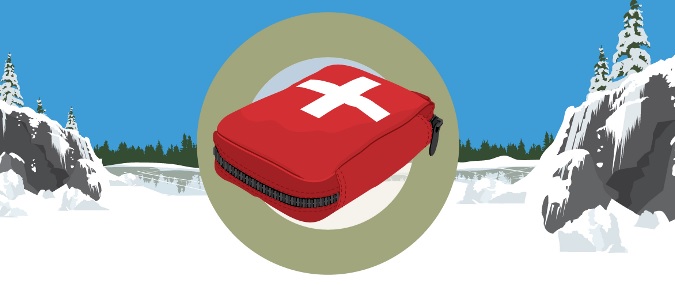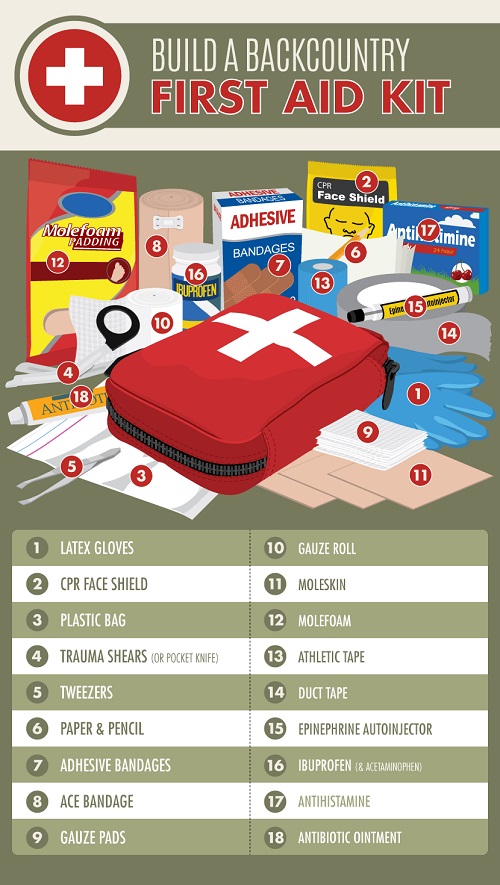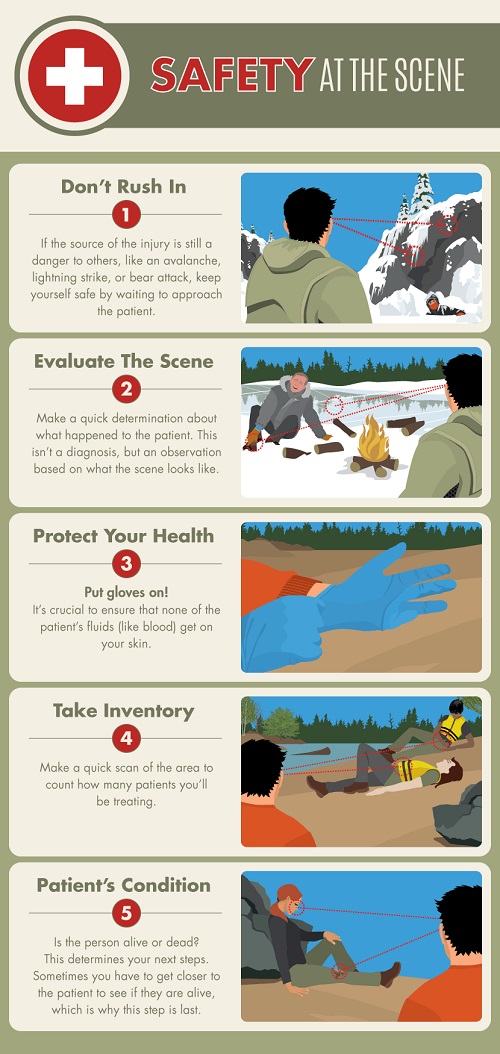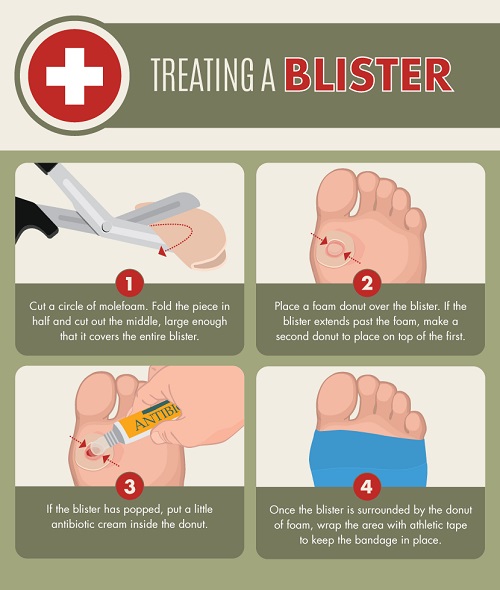One of the scariest things that can happen when you’re in the backcountry is an injury. Even a small blister can upend a backpacking trip, but imagine facing something more serious, like a broken leg, an allergic reaction, or a burn from the campfire, and not knowing where to start. Suddenly it’s abundantly obvious that getting to a hospital isn’t as simple as calling 911, and you wonder where you packed the first-aid kit – you did pack a first-aid kit, right? Having a first-aid kit and knowing how to use it are important parts of making any trip to the backcountry. Here are some tips to get you started.

Take a Course
If you plan on spending time in the backcountry, it’s important to take a course in wilderness medicine. You have three options when choosing a course.
Wilderness First Aid (2–3 days)
This course provides an overview of wilderness medicine, and it is designed for people who plan on taking mostly weekend trips. You’ll learn how to check for threats to life, how to care for wounds and fractures, and how to deal with an emergency in a deliberate way.
Wilderness First Responder (~10 days)
This course is usually required for people who want to work in the outdoors. The material is presented more thoroughly than the material in the short course, and the course covers a wider range of common wilderness injuries.
 Wilderness EMT (one month)
Wilderness EMT (one month)
If you want to be a ski instructor or expect to bounce between EMT work and time in the backcountry, this is a great option. In addition to the national EMT curriculum, the Wilderness EMT includes a component designed for providing remote care.
Don’t be intimidated by the fact that these are all classes; most wilderness medicine courses involve a lot of hands-on learning and scenarios, which provide plenty of chances to practice your skills. Be sure to take a class from a reputable program and keep your certification up to date. Most certifications have to be renewed every two to three years, and most of them include a CPR component. Renewing your certification may seem like a hassle, but it’s a great way to brush up on rusty skills and learn changes to the curriculum or protocols.
First-aid Kit
- Gloves (2–3 pairs Latex or nitrile gloves are essential for anyone treating a patient; pack a few pairs so you won’t run out.
- Band-Aids (10–20): These are great for small cuts and scrapes.
- Ibuprofen and acetaminophen: Sometimes referred to as “Vitamin I,” ibuprofen is great for treating everything from headaches to aching feet.
- Antihistamine and an EpiPen: Allergic reactions happen fast, so make sure you know where the EpiPen and Benadryl are located so you can retrieve them quickly.
- Tweezers: Tweezers are great for removing splinters and ticks.
- Moleskin (2 sheets): These are great for preventing and treating blisters.
- Molefoam (1 sheet): Molefoam provides a fast way to pad a blister.
- Athletic tape (1 roll): Athletic tape can be used for a number of injuries, including twisted ankles and blisters, and it can be used to tape gauze over larger wounds.
- Duct tape: Instead of packing a roll, unwind some tape and wrap it around itself so you can remove pieces.
- Gauze pads (2–3): These are perfect for burns and big cuts.
- Gauze roll: Having two types of gauze may seem redundant, but the roll can be handy for wrapping any number of injuries.
- Antibiotic ointment (3–5 packets): These come in small packets, which are a nice, lightweight option.
- Ace bandage: These are bulky, but they are great for wrapping around splints if you’re dealing with a fracture or simply supporting a rolled ankle.
- Trauma shears or a pocket knife: Scissors aren’t lightweight, but they are indispensible if you need to cut molefoam or remove clothing around an injury. If you opt to leave them behind, be sure to carry a pocket knife.
- CPR face shield: This is a lightweight version of a CPR mask.
- Paper and pencil: These are vital for recording information and taking notes on your patient.
- Plastic bag: These are always useful, but if you’re disposing of biohazardous material, it’s especially important to have one in your kit.
 One of the first things you learn in first-aid training is how to assess a situation to ensure your own safety and that of potential victims. When someone gets injured, your instinct will be to rush to help, but it’s important to take a minute to size up the situation first. These five steps will help you quickly gather important information about the situation before you approach the injured party.
One of the first things you learn in first-aid training is how to assess a situation to ensure your own safety and that of potential victims. When someone gets injured, your instinct will be to rush to help, but it’s important to take a minute to size up the situation first. These five steps will help you quickly gather important information about the situation before you approach the injured party.
1. Make sure the area around the patient is safe for you, the rescuer. This may be a quick decision if the patient simply fell, but consider the scene after an avalanche, a lightning strike, or a bear attack. If the thing that caused the injury is still a danger to others, keep yourself safe by waiting to approach the patient. There’s no sense in creating more patients.
2. Make a quick determination about what happened to the patient. This isn’t a diagnosis but an observation based on what the scene looks like.
3. Put on gloves! It’s crucial to ensure that none of the patient’s fluids (like blood) get on your skin. Gloves are the easiest solution for protecting your hands, and you should wear them at all times while treating a patient.
4. Make a quick scan of the area to count how many patients you’ll be treating. Maybe you’ve stumbled upon a boating accident with a raft full of people, or maybe you’re hiking with a friend who stumbled and fell to the ground.
5. Is the person alive or dead? This may seem basic, but it will give you a lot of information about what your next steps will be and how fast to make them. Sometimes you have to get closer to the patient to see if they are alive, which is why this step is last.
First-aid 101: Blister Prevention
Blisters are a much more likely to occur on a hiking or camping trip than are some of the other incidental injuries a person may incur. Learning how to treat them is a valuable skill that will pay off in dividends. Blisters are essentially burns caused by friction, and they are incredibly common on backpacking trips, especially if you’re wearing brand-new boots. The pre-cursor to a blister is known as a “hot spot.” It’s best to catch blisters at this stage, when they’re easily treated.
If you or your hiking partner discovers a hot spot, stop and take a look at the foot. Hot spots are usually red, and they will be slightly painful to the touch. They’re caused by the foot rubbing against either the boot or the sock, so to treat them, you need to relieve the friction. This is easy to do with moleskin. Simply cut out a circular piece about the size of the hot spot and tape it in place (athletic tape works well for this).
Have the person remove their boot and sock. Take out a square of Molefoam and cut a circle that covers the entire blister, plus a little extra. Round pieces are best because they don’t have any corners, which will peel.
Once you have a circular piece cut, fold the piece in half and cut out the middle, creating a foam donut. The inside hole should be large enough that it covers the entire blister.
Place the foam donut over the blister. If the extends out further than the foam, make a second donut and place it on top of the first. The goal is to create a ring around the blister that will protect it from rubbing against the boot.
If the blister has popped, apply some antibiotic cream inside the donut. If it hasn’t popped, leave it intact. A popped blister is no longer protected by the cushion of the fluid, and it’s an easy access point for infection-causing bacteria. Once the blister is surrounded by the donut of foam, wrap the area with athletic tape to keep the bandage in place.
Now that you know some of the basics, sign up for a wilderness medicine class in your area. Start by checking these three schools that offer nationally recognized certifications: SOLO, WMA, and NOLS Wilderness Medicine.

